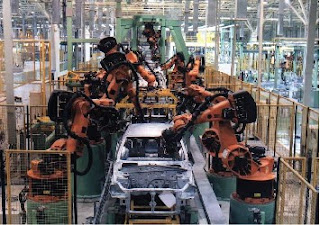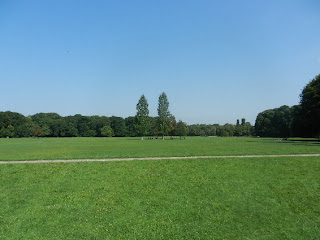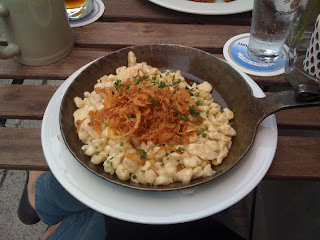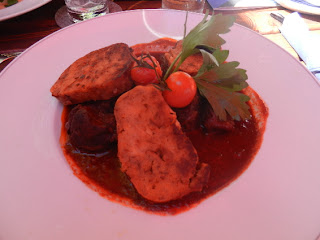I haven't made my mind up yet whether it's ok to like Munich.
It's certainly pleasant here. In fact, it's extraordinarily pleasant. E observed that I seemed more at home in Munich than any place we'd been on The Trip so far. The city has a magical combination of parks and bike paths, great art museums, distinctive fashion, sexy cars, and cozy bier halls with hearty home-cooking. And you can take the train into the countryside to hike past fat cows wearing tinkling bells on lush green hills.
But...
There's no getting around the fact that Munich is the birthplace of Nazism.
Although Hitler was an Austrian citizen, he spent part of his childhood in Bavaria and spoke German with a Bavarian accent. He entered the political arena in Munich in 1923, playing a dramatic lead role in the Beer Hall Putsch ("putsch" means coup). Later, the Nazis kept their headquarters in Munich and built the first concentration camp outside the city at Dachau. They referred to Munich as Hauptstadt der Bewegung or "Capital of the Movement."
Yeah. That's a lot, but unfortunately that's not all.
This city has some seriously bad karma with Jews.
At the 1972 Summer Olympics in Munich, a Palestinian group called Black September took 11 Israeli athletes hostage. Through what many consider bungling by the Munich police, all 11 athletes, one policeman, and five of the assassins, were killed. The three assassins who were captured were later released in concession to Black September's hijacking of Lufthansa flight 181 in 1977. The documentary One Day in September and Steven Spielberg's Munich tell the long story of the original event and its aftermath.
(The photo above is the understated memorial at the Olympics site.)
Well, so, that's really not the end of the story.
If you know something about the history of Jews in Europe before the second world war, you're aware that there were ebbing and flowing tides of anti-semitism for centuries before Hitler was even born. I'm not just talking bad attitudes...
But first, some good news.
A new Ohel Jakob Synagogue opened in Munich in 2006. It was inaugurated on November 9, the 68th anniversary of Kristallnacht, when the original synagogue was razed. The building, designed by architects Wandel Hoefer Lorch, is peculiarly both beautiful and reminiscent of a military fortress. Nearby is a new Jewish Museum and Community Center, which opened one year later, in 2007. Apparently there is an underground tunnel linking the two that houses a memorial to the 4300 Munich Jews killed in the Holocaust.
I didn't see this memorial or go inside the synagogue. You have to arrange these visits weeks in advance (the doors of the synagogue were shut tight). This is a contrast to the many churches around Munich's central Marienplatz, such as the Catholic Frauenkirche, where thousands of visitors breeze in and out unchecked each day.
My experience of the Jewish Museum was distinctly colored by a feeling of anxiety. Never have I been so closely monitored by the staff of a museum. You're not allowed to take pictures (unlike in all the city's other museums), and the staff were reluctant to allow me to return to the coat room for a pen. All of the doors were metal fire doors. It was an uneasy atmosphere, but the information inside was fascinating and candid.

Actually, the information on the outside of the museum was fascinating too. A London artist named Sharone Lifschitz placed an ad in German newspapers saying: “Young Jewish Woman visiting Germany would like to have a conversation about nothing in particular with anybody reading this”. The transcripts of her subsequent conversations cover the windows of the museum. This was the only place I witnessed Germans trying to make sense of their history.
Inside the museum, I was transfixed by a timeline. This will give you a sense of the ebbing and flowing:
1349 -- Jews persecuted and murdered; alleged to have poisoned wells, causing Black Death.
1370 -- Police regulations ban Jews from all professions except money lending.
1442 -- Duke Albert III orders all Jews to be expelled from duchy of Bavaria-Munich.
1553 -- Constitution enforces ban on settlement and trade in Bavaria.
1725 -- Some Jews allowed to settle in Munich as "court Jews" to provide Elector with credit.
1750 -- Only 20 Jews live in Munich.
1777 -- Under Karl Theodor, Jews allowed to settle in Munich.
1815 -- Jewish Community of Munich founded.
1816 -- Unsuccessful bid for equality with Christian subjects.
1848 -- Association for Jewish Advancement founded.
1871 -- Jews have equal rights of citizenship.
1880 -- 4,000 Jews in Munich.
1905 -- 10,000 Jews in Munich.
1910 -- 11,000 Jews in Munich
1920 -- Bavarian government orders deportation of 1500 eastern European Jews (averted).
1924 -- German Alpine Association restricts number of Jews in membership.
1933 -- Jewish establishments boycotted.
1938 -- Hitler orders demolition of Ohel Jakob Synagogue.
1945 -- 3,000 Jews deported and murdered.
1947 -- Only remaining synagogue reopened.
1970 -- Arson attacking Jewish retirement community (seven die).
1972 -- Olympic games massacre.
1989 -- Collapse of Soviet Union; Jews welcomed as quota refugees.
1995 -- Beth Shalom founded.
2005 -- 10,000 Jews in Munich.
While some Jews now living in Munich today had families who lived here during WWII (one woman recalled her mother saying "Go to the corner store and buy us bread from the murderer") -- many come from former Soviet states, in particular Latvia.
How did Soviet Jews reconcile themselves to resettling in Germany? I'm kicking myself for not writing this down, so excuse the paraphrase... One Latvian man recalled hearing about the refugee program but couldn't fathom making a home in Germany. The next day on the bus, someone began wiping his shoes on the man's coat. When he asked them what they were doing, they told him if he didn't like it, he could go back to Israel. So...he took another look at Germany.
Another immigrant said, "I was afraid of coming to Germany. But I now know that I'm living with a different generation of Germans."
Is this a different generation of Germans?
This is Thilo Sarrazin. I'll explain about him in a sec.
A friend asked me how I could bear to visit Dachau. He said he wouldn't be able to go anywhere near it. To the extent I can maintain my composure, I feel it's important to witness what took place here. I don't know why exactly. I guess when society at large can't even tolerate hearing how a group of people were victimized, then the victims themselves take on the stigma of the crime. That seems wrong to me.
So, some distinctive things about Dachau: It was a work camp, rather than an extermination camp. That doesn't mean that people didn't die there. At least 32,000 people died in Dachau during the 12 years it was in operation (on our tour, the guide said 43,000). Dachau provided forced labor to many of the companies we revere today, including BMW, Siemens, and Krupp.
Robbing Jews (and other non-Aryan citizens) of their property and using them as slaves wasn't the only crime committed here. Residents of Dachau were subjects of "medical" experiments that were supposed to aid the German army. One such experiment involved wrapping people in wet blankets and leaving them in the courtyard to see how long it would take for a soldier to freeze to death.
I'm sorry. I know it was upsetting to read that. I'm telling you just one story of what happened at Dachau because the point of the memorial is that visitors should resolve themselves that such inhumanity will "Never Again" happen on their watch. If you're not horrified, if you're not touched, will you make that resolution?
Our guide at Dachau pointed out something interesting to us. "Do you see back there, behind the trees? What is that?" We couldn't really see. It was a guard tower. Guards would gun down anyone who set foot on strip of grass adjacent to the electrified fence. When the camp was in operation, of course, there were no trees obstructing the guard's line of sight. Immediately after the war, trees were planted, which have since grown up, simultaneously obscuring the towers and creating a pleasant leafy park.

This was not the only instance of Dachau slowly and subtly becoming...more pleasant. When you enter Dachau, you look out over the foundations of hundreds of long barracks, where the residents were formerly housed. Our guide took pains to tell us that these are not the original buildings. The original buildings had no foundations to keep out the German winter.
Meanwhile, a large part of the Dachau site has been re-purposed as a riot police training facility. There is a fence running next to the light-colored house you see above. If you try to cross it, you'll be arrested.
As much as we would hope that the resolution "Never Again," would be firmly held across Germany, in 2010, Thilo Sarrazin, former board member of Germany's central bank published a controversial (and popular!) book about German immigration policy and Muslims; and subsequently made a very creepy comment about genetics: "all Jews share a certain gene, all Basques have certain genes that make them different from other people."
Our guide mentioned something else in passing that made my jaw drop:
Did you know that Hugo Boss produced Nazi uniforms? This was not a case of grudging participation to keep the business afloat. Boss joined the Nazi party early, in 1931, and was an official supplier of uniforms from 1932 on, as well as a user of forced labor. While we were in Munich, the stores were full of these Hugo Boss advertisements featuring a very blond Gwyneth Paltrow:
It was at this point that I started getting uncomfortable. I bought a Hugo Boss bag in Hong Kong...and what were we doing in Bavaria anyway? I don't know. I've always just felt this attraction to Southern Germany. Maybe it's the Alpine fashion. I really like dirndls...


One of my funnest days in Munich was spent dirndl-shopping at a thrift store called Kleidermarkt. I don't know where I'm ever going to wear this, but I absolutely love it.
The other thing that I love aesthetically about Bavaria is that women wear their hair in braids a lot here...
I've had my eye on braids since seeing a picture of former Ukranian Prime Minister, Yulia Tymoshenko a few years ago. But then I remember my friend D telling me that Ukranians were especially treacherous collaborators with the Nazis (160 concentration camps were built in the Ukraine and almost 1 million Jews died there). And I remember that recent Jewish immigrants to Munich left neighboring Latvia.
Is it ok to like dirndls? Is it ok to like braids? Is it creepy? Aesthetics were not a sideline issue in the success of the Nazi movement. I don't know the answer.
Another fun day was visiting the Deutsches Museum. Never in my life have I seen such a detailed and complete science museum. Actually, it's a science, technology, and engineering museum. The list of exhibits is massive, ranging from aeronautics to optics to machine tools to metal casting to nanotechnology...
One popular event during the day is the demonstration of the high-voltage unit. This is annotated in the directory as "very loud; also for groups". I don't know what they were doing, but a guy who looked like Elvis came out, put his colleague in a round cage, hoisted it to the ceiling, and ran gigantic amounts of electricity very close to him. The crowd oohed, ahed, and giggled. It was, in fact, "very loud."
Because E was a pilot and instrument instructor, I love going with him to any type of airplane exhibit. I get to ask him silly questions about luggage storage in wide body jets like the Lufthansa cross-section you see above, or he explains to me for the nth time how jet engines work.
There was a very detailed exhibit about the evolution of jet engines, in which I learned about the relative merits of the rotary compressor (designed by Rolls Royce) and the axial compressor (shown above), which was developed by BMW.
Then we got lost for hours in the mining labyrinth underneath the main museum, which seemed to have been designed by a mining-ophile with an unlimited budget at Krupp. Krupp, the maker of this insane piece of copper mining equipment you see below...
We surfaced somewhere near this detailed scale model of a power station (how many science museums have one of these?), consumed a sausage and a weissbier in the cafeteria and went back for more.
Again, here were those same names I'd encountered before -- BMW, Krupp, Siemens -- all users of forced labor, here presented as the engineering heroes of Bavaria.
Later, we went and took a tour of the BMW plant. In their introductory video, they acknowledge using forced labor, express "deep regret," and claim to have set up a reparations fund. Is this adequate? How do you atone for enjoying success that was built on dehumanizing and robbing an innocent group of people? Then again, I suppose I should know the answer to that, being an American.
For some reason I'm thinking about Hong Kong again. I remember Jason Wordie telling us that, typically, in Chinese culture, people perform ancestor worship for five generations of their forebears. But that's the limit.
Is there a statute of limitations for something like this?
Well, so we went to BMW and we saw their awesome factory with the brilliant KUKA robots (made in Germany), that perform dozens of precision welds simultaneously in teams of ten or so. Really amazing.
BMWs are everywhere in Munich. I would walk down the streets and see them pulled up to the curb in great blocks, occasionally interspersed with other German cars. Like this picture I snapped near Odeonsplatz: BMW, BMW, Audi, BMW, Audi, Mercedes. And yes, don't even get me started on VW and Daimler-Benz...
For a semi-retired car nut like me, Munich is a dreamy place to car-gaze. Besides the gorgeous old vintage BMWs cruising around, like this elegant 2002...
...there were Porsches in the trendy "not-shining" finish (as our BMW plant guide described it),
...and a wild Wiesmann Roadster.
Check out this picture of the Wiesmann brothers Friedhelm and Martin at an early age:
They remind me of a group of boys we saw riding the train from Munich out to Lenggries. Like a pile of puppies, they plopped themselves down in a block of seats near us and quickly began snoring. One of them managed to open a Sunday morning beer and take a sip before nodding off. Somehow, even while drooling, he managed to keep it upright.
God, that was a cold and rainy summer day. Determined to get a taste of Bavarian nature, we took the Brauneck cable car near Bad Tolz to the top of what is usually a ski hill, and in the summer, a hiking destination. During our visit, it seemed to be a mix of the two (i.e., it was cold).
When we got to the top, the biergarten at the Panorama Restaurant looked like this:
Um, no.
We opted for Jägertee (hot, sweet, paint thinner) and pretzel soup indoors. Very good choice!
Thus fortified, I went out to commune with nature while E stayed cozy and communed with the Kindle.
What were we doing in Bavaria anyway? This is really it. This combination of voluptuous nature and stick-to-your-ribs, homey food. So good, separately, and in combination. Münchners love a good leafy park. Their city is filled with them. I don't know if you can see all of the green in this map.
First, there's the massive English Garden. I gotta put this massiveness in perspective... The English Garden is 370 hectares, or 1.4 square miles. That's 9% larger than Central Park in NYC, which is 341 hectares. But it's worth thinking about the respective populations too... Munich proper has about 1.3 million people while NYC has 8.2 million. So there's a whole lot more park-per-person in Munich.
I kept getting swallowed up by the English Garden. There are almost 40 km of trails in the park.
Interestingly, the English Garden was the brainchild of an American, Sir. Benjamin Thompson, who was born in Woburn, Mass (not making this up). Amazing guy -- physicist, inventor, designer of warships (and gardens), knighted in the UK, a count in the Holy Roman Empire, and...drum roll please...introduced the cultivation of potatoes in Bavaria. A+ for this guy!

Then there were the beautiful grounds of the Nymphenburg Palace. This was the summer home of the Wittelsbachs, the family that ruled Bavaria for 738 years, from 1180 to 1918.
I was totally enchanted; it was the most delightful place for walking. Inside the palace there is a portrait of Maria Amalia of Austria, wife of Holy Roman Emperor Charles VII (aka Karl Albrecht). She has ruddy cheeks, loved to hunt, and was apparently a great fan of dogs. I imagine her walking these paths...

We dug the biergarten thing. It's nice munching a sausage, some sauerkraut, and a pretzel under a canopy of chestnut trees. And I have to say, the sauerkraut at the Chinesischer Turm Biergarten (seats only 7,000) hit the spot. It had caraway seeds, bay leaf, and bacon in the brine. That's the way it's supposed to taste.
In the end, though, we liked the smaller gartens and cozy bier halls. There are as many Italian restaurants as there are German in Munich, but we ate German the whole time. It was like we were on a brezin and schnitzel marathon (the schnitzel is a greatly under-appreciated dish). Let me just tantalize you with a few of our favorites...
Wafer-thin schnitzel with fresh horseradish and cranberry at Kaisergarten. Oh yeah. I don't know if they put quark in the horseradish, but it had this fantastic combination of pepperiness and creaminess. Quark is fantastic, by the way, a kind of fluffy cream-cheesy number. This German food site says Germans eat 17 lbs per person per year!
There was the competing schnitzel at Gasthaus Weinbauer, with a brezin-crust (how could you say no?), where they also had knockout homemade spaetzle with fried onions, a traditional "vegetarian" Bavarian offering.
Then there were the competing brezin at Palais Keller (I think we ate 12!) and Wintergarten (big men in lederhosen strode out of the kitchen with a basketfull and tossed their dark crunchy bodies like fish onto the sideboard).
Bavarian brezin are different from the soft pretzels I'm used to eating from street vendors in the US. They're actually crunchy-ish on the outside, and they have that amazing brown-bitter flavor from being dipped in lye before they're baked. It's common to eat them with weisswurst and süßer senf, as I am in the second photo. Süßer senf is that coarse mustard sweetened with brown sugar. An absolute perfect flavor-marriage with the bittery-brown-lye flavor. Yum, yum, yum.
Oh man, and then there were the various stewed beef dishes at Der Pschorr, a Munich brewery and institution connected in some way with the whole Slow Food movement. This dish came with brezin-dumplings and a side of creamy dill-cucumber salad. This is so up-my-palate, I can't tell you.
Oh gosh, and then there was the tasty little pork-and-veal meatloaf that was the perfect chewy texture at Unions-Bräu-Haidhausen. They had good brezin too.
I don't know what it is about this cuisine, but I just love it. It's like the perfect thing you want to eat after having hiked up a freezing mountain with fat cows or bicycled 30 km around the city on your turquoise bicycle with the strawberry seat cover. It's so...satisfying and tasty. Meaty-tangy-salty-creamy get high marks in my book.
Oh gosh, this post's a mile long and I haven't even talked about all of the excellent art and treasures the Wittelsbachs bankrupted themselves buying. I'll just give you a visual taste...
I think it was this crown that once housed the Wittelsbach Diamond, the world's second-largest blue diamond, sold when the family was close to bankruptcy.
The treasure trove of Max Beckman paintings at the Pinakothek der Moderne.
The mesmerizing Battle of Issus painting by Albrecht Altdorfer at the Alte Pinakothek.
Can you tell how much I enjoyed Munich? But I couldn't let myself fully relax.
Each time something delighted me, I recalled its connection to an under-current of anti-semitism. Marveling at the Wittelsbach's outrageous palaces, I recalled that Jews were banned from Munich except to loan the royals money. Enjoying Munich's leafy parks, I thought of the greenery obscuring the horrors of Dachau. Even enjoying the gregarious bier hall energy, I thought of that energy being harnessed by Hitler during the Bier Hall Putsch. I thought of those fantastic BMWs built on an economic foundation of slave labor.
The culture is so charming, but I felt I couldn't trust it. Have you ever read John le Carré's Tinker, Taylor, Soldier, Spy? Hopefully I'm not ruining it for you...but the really bad guy, the big deceiver, the mole...is the charmer. He's handsome, chummy schoolboy who everyone gets along with. That's what worried me about Munich. Was there something about the charm that also made it so poisonous?
So I did what anyone would do... Track down a 37-page cross-cultural study called "Extreme mass homicide: From military massacre to genocide" (by faculty at University of B.C., Simon Fraser University, and Chinese University of Hong Kong). This paper looked at events in Armenia, the Ukraine, Cambodia, Rwanda, Bosnia, China, Vietnam, and Guatemala.
This was depressing. One would like to think that genocide is a rare event. But really, it seems to be universal. Some dimensions are consistent: often, the perpetrators experience humiliation; and often the victims are targeted because they were successful in some way. But beyond that, there were no common elements in the cultures of Cambodia, Guatemala, and Bavaria, that somehow created a noxious brew.
Yet...
...even if what happened is not necessarily born from the culture (or from the aspects of culture that I like), that doesn't erase the history of what one group of people did to another in this place.
After I read this paper, I started having nightmares. E marveled at my nuttiness. This happened 70 years ago. Anyone who directly participated is probably dead by now.
And then we were bombed. By ourselves! I'm not making this up.
A construction crew not 500 meters from our flat, were tearing down an old building to put in a new bier hall, and found a 550-lb American bomb. The fire department cruised by our flat calling out on megaphones "Hier spricht die Feuerwehr." Go inside and close the windows.
We did. We waited, we waited, we waited. Finally, sometime after 10pm, this bomb which lay silently under central Munich, almost directly under the Munchner Freiheit U-Bahn station, went...oomph. Even with the buffers they built all around it, it shattered windows for blocks around.






















































No comments:
Post a Comment